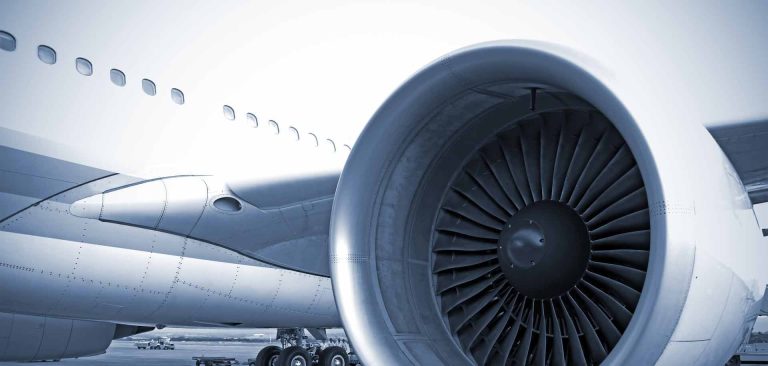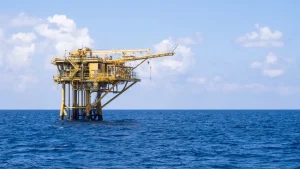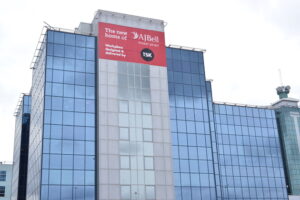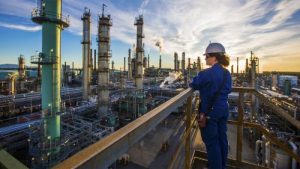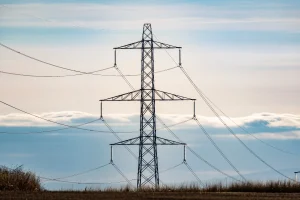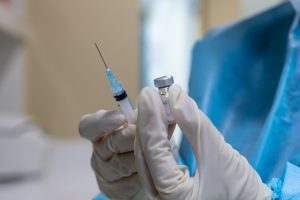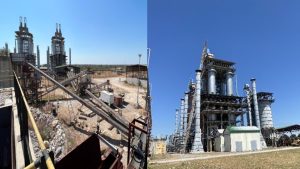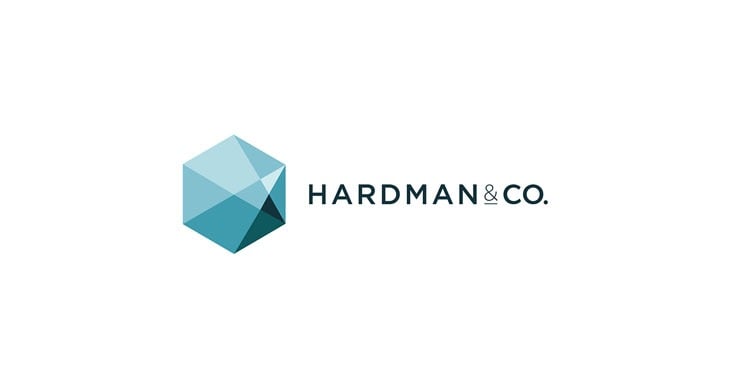Rolls-Royce Holdings plc (LON:RR) has announced its 2023 Full Year Results.
Step-change in performance driven by transformation; strong momentum into 2024
- Underlying operating profit of £1.6bn and underlying margin of 10.3%, reflecting the impact of our strategic initiatives, with commercial optimisation and cost efficiency benefits across the Group
- Record free cash flow of £1.3bn driven by operating profit and continued LTSA balance growth
- Return on capital more than doubled to 11.3% reflecting improved operating profit, disciplined capital allocation and working capital management
- Statutory net cash flow from operating activities of £2.5bn, £1.0bn higher year on year
- Net debt of £2.0bn, down from £3.3bn at the end of 2022, as we strengthen the balance sheet and build resilience
- 2024 guidance: continued progress with underlying operating profit between £1.7bn and £2.0bn and free cash flow between £1.7bn and £1.9bn
Tufan Erginbilgic, Rolls-Royce Holdings CEO said: “Our transformation has delivered a record performance in 2023, driven by commercial optimisation, cost efficiencies and progress on our strategic initiatives. This step-change has been achieved across all our divisions, despite a volatile environment with geopolitical uncertainty, supply chain challenges and inflationary pressures.
We are managing the business differently and our significant performance improvement in the year reflects the hard work and focused actions of all our teams. We are also continuing to invest to drive future sustainable growth. Our strong delivery in 2023 gives us confidence in our 2024 guidance and is a significant step towards our mid-term targets. We are unlocking our full potential as a high-performing, competitive, resilient, and growing Rolls-Royce.”
Full Year 2023 Group continuing operations
| Underlying2023 | Underlying 2022 | Statutory 2023 | Statutory2022 | |
| £ million | ||||
| Revenue | 15,409 | 12,691 | 16,486 | 13,520 |
| Operating profit | 1,590 | 652 | 1,944 | 837 |
| Operating margin (%) | 10.3% | 5.1% | 11.8% | 6.2% |
| Profit/(loss) before taxation | 1,262 | 206 | 2,427 | (1,502) |
| Earnings/(loss) per share (pence) | 13.75 | 1.95 | 28.85 | (14.24) |
| Free cash flow | 1,285 | 505 | ||
| Return on capital (%) 1 | 11.3% | 4.9% | ||
| Net cash flow from operating activities 2 | 2,485 | 1,524 | ||
| Net debt | (1,952) | (3,251) |
1 Adjusted return on capital is defined on page 52 and is abbreviated to return on capital
2 Represented. See page 18 for further details
A reconciliation of alternative performance measures to their statutory equivalent is provided on pages 49 to 52
2023 performance summary
· Driving growth in attractive markets: Large engine flying hours (EFH) in Civil Aerospace recovered to 88% of 2019 levels, up from 65% in 2022. Large engine orders were the highest in more than 15 years, with major orders from Air India and Turkish Airlines. In Defence, the AUKUS submarine agreement was announced, which will be supported by the expansion of our submarines site in Raynesway, and work on our future programmes in the UK and US progressed well. In Power Systems, we are capturing strong demand for power generation solutions and services in the rapidly expanding data centre market.
· Significantly improved profit and margins: Underlying operating profit rose by £0.9bn to £1.6bn supported by our transformation programme and strategic initiatives, with commercial optimisation and cost efficiency benefits across the Group. Underlying operating margin more than doubled to 10.3%. Civil Aerospace, Defence and Power Systems all delivered materially higher margins compared to last year. The largest improvement was in Civil Aerospace, which delivered an operating margin of 11.6% compared to 2.5% in the previous year. This was driven by increased aftermarket profit, in both the large engines and business aviation segments, reflecting commercial optimisation and cost efficiencies, as well as volume growth. Defence delivered an improved operating margin of 13.8% (2022: 11.8%), which primarily reflected improved pricing and cost efficiencies. In Power Systems, which reported an operating margin of 10.4% (2022: 8.4%), pricing and cost efficiency actions in the first half of the year resulted in a significantly improved operating profit and margin in the second half and in the full year.
· Record cash generation: Free cash flow from continuing operations grew by approximately 150% to £1.3bn, principally due to higher operating profit. Civil net LTSA creditor growth net of risk and revenue sharing agreements (RRSAs) was £1.1bn (2022: £0.8bn). Continued LTSA balance growth reflects higher EFHs and the benefit of commercial optimisation, with LTSA invoiced flying hour receipts of £4.6bn (2022: £3.6bn). Our focus on working capital resulted in a release in the second half despite ongoing supply chain challenges. For the full year there was a net working capital outflow of £0.4bn (2022: £0.5bn). Inventory and debtor days both improved year on year building further confidence in the actions we are taking to improve the quality of cash delivery.
· Building financial resilience: Total underlying cash costs as a proportion of underlying gross margin (TCC/GM) ratio improved to 0.59x in 2023 from 0.80x in 2022. Net debt improved to £2.0bn (2022: £3.3bn). We have £4.1bn of drawn debt, of which £0.5bn matures in 2024, £0.8bn in 2025 and £2.8bn in 2026-2028, and £1.7bn of lease liabilities. We have £3.7bn in cash and cash equivalents and £3.5bn undrawn facilities, totalling £7.2bn of liquidity, and expect to repay the 2024 and 2025 bonds from cash. We cancelled a £1.0bn undrawn UK Export Finance (UKEF) backed facility in the year, and a £1.0bn undrawn bank loan facility reflecting our higher cash balance and more resilient financial position.
· Shareholder payments: We are not making shareholder payments for 2023. As we shared at our capital markets day in November 2023, once we are comfortably within an investment grade profile and the strength of our balance sheet is assured, we are committed to reinstating and growing shareholder distributions.
Transformation programme and strategic review
The early results of our transformation programme and strategic initiatives are already evident in the step-change in performance reported for 2023, but there is more still to do. Our strategy framework is founded on four pillars:
· Portfolio choices & partnerships: We have clear plans for the markets we will operate and invest in. In Civil Aerospace, we successfully tested our UltraFan demonstrator engine to full power and achieved certification for our Pearl 700 business jet engine. In Defence, investment continued in the growing combat, transport and submarines markets and we progressed well with testing and development on the GCAP and B-52 programmes. In Power Systems, we successfully tested a new engine prototype that will join our portfolio alongside our current Series 4000 and acquired a yacht automation and bridge specialist business to extend our Marine offering. We also identified areas for divestment, which we expect to generate £1.0bn-£1.5bn gross proceeds by 2028. We are in advanced discussions to sell the off-highway lower power range engines division in Power Systems and we decided to exit Electrical in the short term or alternatively, for the right value, reduce our position to a minority with an intention to exit fully in the mid-term.
· Advantaged businesses & strategic initiatives: In Civil Aerospace, we have now retrofitted 20% of the Trent 7000 fleet with the improved HPT blade, which has doubled its time on wing, and we expect the same improvement to be certified on the Trent 1000 TEN in 2024. All key Civil Aerospace OEM and major airline contract renegotiations were either concluded or progressed. Our cost initiatives reduced total shop visit costs across large engines dispatched in 2023, which helped to deliver an improved LTSA margin. In Defence, cost efficiencies and value-based pricing helped to deliver improved performance and we delivered strong growth in combat and submarines. In Power Systems, in addition to our pricing and cost actions, we commissioned one of the largest battery and energy storage systems in Europe, helping to integrate renewable energy into the Dutch public grid and grow our power generation business.
· Efficiency & simplification: Our actions to deliver sustainable cost efficiencies and improve competitiveness are well underway. In 2023, we delivered around £150m towards an annualised total Efficiency & Simplification savings target of £400m-£500m in the mid-term. We announced a reduction of 2,000-2,500 roles by the end of 2025 with expected annual benefits of approximately £200m and associated severance costs of £200m-£250m, which will be taken as an exceptional charge in 2024. We also have a renewed focus on third party costs, where we delivered gross savings of £130m in the year, making a strong start towards our target to save £1bn gross procurement spend by the mid-term, helping to partly offset inflationary pressures. In 2024, we have launched zero based budgeting, focusing initially on Civil Aerospace.
· Lower carbon & digitally enabled businesses: We remain committed to becoming a net zero company by 2050 and supporting our customers to do the same. In 2023 we powered the first 100% sustainable aviation fuelled commercial flight across the Atlantic and met our target for 100% SAF compatibility testing for our in production commercial aero engines. Our S2000 and S4000 engines in Power Systems were approved for use with sustainable fuels and we also progressed our hydrogen test programmes. We invested in digital tools as we look to unlock the potential to remove 20% of repetitive tasks with digital and AI capability.
Delivery of our strategic framework and clear plans for the mid-term will realise our Rolls-Royce proposition to become a high-performing, competitive, resilient and growing business. Our people are energised and aligned to the new One Rolls-Royce ways of working and our progress to date further strengthens our confidence in the delivery of our mid-term targets.
Outlook and 2024 Guidance
As we continue to deliver our strategy, we expect further improvements towards all our mid-term targets. This is despite the impact of continued supply chain challenges, which we expect to persist for 18-24 months, geopolitical uncertainty and inflationary pressures.
| 2024 financial guidance | |
| Underlying operating profit | £1.7bn-£2.0bn |
| Free cash flow | £1.7bn-£1.9bn |
In Civil Aerospace, we expect 2024 large EFHs will grow to 100-110% of 2019’s level, 500-550 total original equipment (OE) deliveries and 1,300-1,400 total shop visits. Our 2024 free cash flow guidance is based on civil net LTSA creditor growth at the low end of the mid-term range (£0.8bn – £1.2bn), compared to £1.1bn in 2023. Additional detail is included in the results presentation and supplementary data slides.
Strong progress in the early years of our plan demonstrates a front-end loaded delivery of performance improvement. Our 2023 performance and 2024 guidance on operating profit and free cash flow means that by 2024 we will have delivered more than 50% of the improvement set out in our mid-term targets. As a reminder, we are targeting underlying operating profit of £2.5bn-£2.8bn, operating margin of 13-15%, free cash flow of £2.8bn-£3.1bn and return on capital of 16-18% in the mid-term. These targets are based upon our expectations for a 2027 timeframe.
Underlying financial performance by division
| £ million | Underlying revenue | Organic Change 1 | Underlying operating profit/(loss) | Organic change 1 | Underlying operating margin | Organic margin change (pts) |
| Civil Aerospace | 7,348 | 29% | 850 | 497% | 11.6% | 9.1pt |
| Defence | 4,077 | 12% | 562 | 30% | 13.8% | 1.9pt |
| Power Systems | 3,968 | 16% | 413 | 44% | 10.4% | 2.0pt |
| New Markets | 4 | nm | (160) | (20)% | nm | nm |
| Other businesses | 12 | nm | (15) | 52% | nm | nm |
| Corporate/eliminations | − | nm | (60) | (49)% | nm | nm |
| Total (continuing operations) | 15,409 | 21% | 1,590 | 143% | 10.3% | 5.2pt |
1 Organic change is the measure of change at constant translational currency applying full year 2022 average rates to 2023. All underlying income statement commentary is provided on an organic basis unless otherwise stated
All results are shown for Group continuing operations, on an underlying basis, excluding discontinued operations (ITP Aero). For more details, see note 2 of the Condensed Consolidated Financial Statements (page 22).
nm is defined as not meaningful
Trading cash flow
| £ million | 2023 | 2022 |
| Civil Aerospace | 626 | 226 |
| Defence | 511 | 426 |
| Power Systems | 461 | 158 |
| New Markets | (63) | (57) |
| Other businesses | 5 | 5 |
| Corporate/eliminations | (57) | (49) |
| Total trading cash flow (continuing operations) | 1,483 | 709 |
| Underlying operating profit charge exceeded by contributions to defined benefit schemes | (26) | (32) |
| Taxation | (172) | (172) |
| Total free cash flow (continuing operations) | 1,285 | 505 |
Civil Aerospace
| 2023 key operational metrics: | Large engine | Business aviation/ regional | Total | Change |
| Original Equipment (OE) deliveries | 262 | 196 | 458 | 29% |
| LTSA engine flying hours (millions) | 13.5 | 3.0 | 16.5 | 25% |
| Total LTSA shop visits | 839 | 388 | 1,227 | 18% |
| …of which major shop visits | 368 | 363 | 731 | 27% |
Significantly improved Civil Aerospace operating profit and margins reflect higher aftermarket profit, due to increased volumes, commercial optimisation, and cost efficiencies.
Civil Aerospace large EFHs rose by 36% year on year to 88% of 2019 levels, reflecting the continued strong demand for travel coupled with a recovery in traffic in China as COVID-19 restrictions eased. Business aviation demand remained robust. In 2023, around 700 large engines were ordered, the highest level since 2007 including major orders from Air India, Emirates and EVA Air. Turkish Airlines also placed an order for new engine deliveries in 2023, which is set to make them the largest operator of Trent XWB engines in the world. In January 2024 we also received a substantial order from Delta Airlines for 40 Trent XWB-97 engines. Our large engine order book increased by almost 30% to 1,632 engines at year end with a 2023 book to bill of 2.6x.
Total OE engine deliveries rose by 29% year on year, with 196 business aviation deliveries (2022: 165) and 262 total large engine deliveries (2022: 190). In 2023 we delivered 53 large spare engines (2022: 44), which represented 20% of total large engine deliveries (2022: 23%). Total shop visits increased 18% year on year to 1,227 (2022: 1,044), of these 368 were large engine major shop visits (2022: 248). The ramp up in shop visits was achieved despite ongoing supply chain constraints.
Underlying revenue of £7.3bn increased 29% year on year, driven by higher shop visits and OE engine deliveries and commercial optimisation. Underlying OE revenues grew by 36% in the year to £2.7bn and services revenues grew by 25% to £4.6bn. LTSA revenue catch-ups were £(104)m (2022: £360m).
Underlying operating profit was £850m (11.6% margin) versus £143m in 2022 (2.5% margin). The year on year improvement was driven by higher large engine LTSA shop visit volumes and profitability, increased time and materials profits from life limited parts sales for large engines, and higher business aviation profits, again driven by aftermarket profit growth. In each case, our commercial optimisation actions helped drive margin improvements. This was complemented by cost efficiencies, with lower indirect costs net of inflation.
Contract catch-ups were £(29)m (2022: £319m). The prior year benefitted from material positive contract catch-ups mostly associated with inflation assumption changes in 2022. Net onerous provisions/releases were £(25)m
(2022: £51m). We made good progress on onerous contracts in the year, releasing £385m of provisions taken in prior periods. However, this was more than offset by £410m new provisions taken in 2023 mostly related to industry wide supply chain constraints.
Trading cash flow was £626m versus £226m in 2022. Improved cash flows were driven by higher operating profit, continued strong growth in the LTSA balance, partly offset by net working capital movements and increased investments in the year including improving time on wing for our Trent engines, investment in the Pearl business aviation engines and the UltraFan demonstrator engine test. LTSA invoiced flying hour receipts increased to £4.6bn (2022: £3.6bn).
Defence
Higher operating profit in Defence was driven by our commercial optimisation action, cost efficiencies and volume growth in submarines.
Demand remained strong in all key markets – transport, combat and submarines – with order intake of £5.2bn in the year; a book-to-bill ratio of 1.3x. This resulted in a record order backlog of £9.2bn at the year end, with 90% order cover in 2024 and a high degree of cover in 2025 and beyond. Key awards in the year included the AUKUS agreement, which underpins the long-term growth outlook for our submarines business.
Revenues increased by 12% in 2023 to £4.1bn, with year-on-year growth in all major end markets, notably
double-digit revenue growth in combat and submarines. Combat growth was driven by the GCAP programme in the UK and the ramp-up of the F130 programme for the B-52 in the US. Total OE revenues grew by 8% in the year to £1.8bn and services revenues grew by 14% to £2.3bn.
Operating profit was £562m (13.8% margin) versus £432m (11.8% margin) in the prior year, reflecting commercial optimisation, cost efficiencies, and growth in submarines. A lower R&D charge reflected increased customer funding and our strategic focus on the most attractive future programmes.
Trading cash flow of £511m improved versus £426m last year, driven by higher underlying operating profit and our working capital initiatives which resulted in inventory reductions, and increased customer deposits.
Power Systems
In Power Systems, as we stated in our upgraded 2023 guidance at the half year, our cost and pricing actions in the first half of the year supported a significantly higher margin and profit in the second half, and a higher margin for the full year, with a material improvement in power generation profit, taking the division to a level which represents an all-time record in the 114 year history of the business.
Order intake in Power Systems was £4.3bn, flat year on year, but with a book-to-bill ratio of 1.1x and OE order coverage for 2024 of 80%. Demand remained strong with high order intake in power generation and governmental in particular.
Underlying revenue was £4.0bn, an increase of 16% year on year with 34% growth in the power generation end market driven by data centre growth, where we have a leading position. Underlying OE revenues grew by 19% to £2.7bn. Underlying Services revenues grew by 10% to £1.3bn.
Operating profit was £413m, a 44% year on year increase. This was driven by commercial optimisation and cost efficiencies. In power generation, profitability tripled in 2023 as we took steps to ensure we are appropriately remunerated for our products and services through value-based pricing. The year on year improvement in operating margin to 10.4% in 2023 versus 8.4% in 2022 was achieved despite a slight product mix headwind in the year.
Trading cash flow was £461m with a conversion ratio of 112% versus £158m and 56% last year. The increase in trading cash flow was due to increased operating profit and working capital initiatives including a benefit from increased customer advance payments and reduced inventories in the year.
New Markets
Rolls-Royce SMR (small modular reactors) continued to progress well through stage two of the Generic Design Assessment (GDA) regulatory process in the UK. First power is still planned in the early 2030s, which will be dependent on securing orders and the outcome of the final investment decision by the UK Government. In 2023 we were successfully shortlisted in the first stage of the Great British Nuclear Small Modular Reactor technology selection process and look forward to the next steps.
Planned cost increases in both Electrical and SMR to meet development milestones resulted in an increased operating loss of £(160)m a 20% increase from £(132)m in the prior year.
Trading cash flow was an outflow of £(63)m compared to £(57)m in the prior year, with SMR costs covered by third party funding.
Statutory and underlying Group financial performance from continuing operations
| 2023 | 2022 | |||||
| £ million | Statutory | Impact of hedge book 1 | Impact of acquisition accounting | Impact of other non-underlying items | Underlying | Underlying |
| Revenue | 16,486 | (1,077) | − | − | 15,409 | 12,691 |
| Gross profit | 3,620 | (461) | 46 | 26 | 3,231 | 2,477 |
| Operating profit | 1,944 | (475) | 50 | 71 | 1,590 | 652 |
| Gain arising on disposal of businesses | 1 | − | − | (1) | − | − |
| Profit before financing and taxation | 1,945 | (475) | 50 | 70 | 1,590 | 652 |
| Net financing income/(costs) | 482 | (915) | − | 105 | (328) | (446) |
| Profit before taxation | 2,427 | (1,390) | 50 | 175 | 1,262 | 206 |
| Taxation 2 | (23) | 285 | (12) | (370) | (120) | (48) |
| Profit for the year from continuing operations | 2,404 | (1,105) | 38 | (195) | 1,142 | 158 |
| Basic earnings per share (pence) | 28.85 | 13.75 | 1.95 | |||
1 Reflecting the impact of measuring revenue and costs at the average exchange rate during the year and the valuation of assets and liabilities using the year end exchange rate rather than the rate achieved on settled foreign exchange contracts in the year or the rate expected to be achieved by the use of the hedge book
2 Taxation includes the recognition of a deferred tax asset on UK tax losses of £328m in other non-underlying items
Revenue: Underlying revenue of £15.4bn was up 21%, with double-digit growth in all three core divisions and particularly strong growth in Civil Aerospace. Statutory revenue of £16.5bn was 22% higher compared with 2022. The difference between statutory and underlying revenue is driven by statutory revenue being measured at average prevailing exchange rates (2023: GBP:USD 1.24; 2022: GBP:USD 1.24) and underlying revenue being measured at the hedge book achieved rate during the year (2023 GBP:USD 1.50; 2022: 1.50).
Operating profit: Underlying operating profit of £1,590m (10.3% margin) versus £652m (5.1% margin) in the prior year. This was due primarily to strong aftermarket growth in Civil Aerospace and commercial optimisation and cost efficiencies across the Group. The largest year on year improvement in margin was in Civil Aerospace, but Defence and Power Systems margins also rose materially. Statutory operating profit was £1,944m, higher than the £1,590m underlying operating profit largely due to the £475m negative impact from currency hedges in the underlying results. Net charges of £71m were excluded from the underlying results as these related to non-underlying items comprising net transformation and restructuring charges of £102m; partly offset by net impairment reversals of £8m, the write back of exceptional Trent 1000 programme charges of £21m; and a £2m pension past service credit.
Profit before taxation: Underlying profit before taxation of £1,262m included £(328)m net financing costs comprising £164m interest receivable, £(275)m interest payable and £(217)m of other financing charges and costs of undrawn facilities. Statutory profit before tax of £2,427m included £515m net fair value gains on derivative contracts, £(205)m net interest payable and net foreign exchange gains of £394m.
Taxation: Underlying tax charge of £(120)m (2022: £(48)m) reflects a tax charge on profits of £(198)m net of a tax credit arising on the recognition of a £78m deferred tax asset on previously unrecognised UK tax losses. The 2022 underlying tax charge relates to tax on overseas profits of £(175)m net of a tax credit on the increase in certain UK deferred tax assets of £127m. The statutory tax charge of £(23)m is lower than the underlying charge due to an additional £328m recognition of a deferred tax asset on UK tax losses. This is partially offset by a net tax charge of £(231)m on non-underlying items.
Free cash flow
| 2023 | 2022 | |||||
| £ million | Cash flow | Impact of hedge book | Impact of acquisition accounting | Impact of other non-underlying items | Funds flow | Funds flow |
| Operating profit | 1,944 | (475) | 50 | 71 | 1,590 | 652 |
| Operating profit from discontinued operations | − | − | − | − | − | 86 |
| Depreciation, amortisation and impairment | 1,019 | − | (50) | 9 | 978 | 953 |
| Movement in provisions | (325) | 46 | − | 21 | (258) | (23) |
| Movement in Civil LTSA balance | 1,708 | (377) | − | − | 1,331 | 792 |
| Movement in prepayments to RRSAs for LTSA parts | (315) | 63 | − | − | (252) | (8) |
| Settlement of excess derivatives 1 | (389) | − | − | − | (389) | (326) |
| Interest received | 159 | − | − | − | 159 | 36 |
| Other operating cash flows 2 | (63) | (8) | − | 3 | (68) | 5 |
| Operating cash flow before working capital and income tax | 3,738 | (751) | − | 104 | 3,091 | 2,167 |
| Working capital (excluding Civil LTSA balance and prepayment to RRSAs) 3 | (236) | (123) | − | (37) | (396) | (524) |
| Cash flows on other financial assets and liabilities held for operating purposes | (845) | 853 | − | − | 8 | 77 |
| Income tax | (172) | − | − | − | (172) | (174) |
| Cash from operating activities | 2,485 | (21) | − | 67 | 2,531 | 1,546 |
| Capital element of lease payments | (291) | 21 | − | − | (270) | (198) |
| Capital expenditure | (699) | − | − | 4 | (695) | (504) |
| Investment | 69 | − | − | − | 69 | 28 |
| Interest paid | (333) | − | − | − | (333) | (352) |
| Other | 54 | − | − | (71) | (17) | (29) |
| Free cash flow | 1,285 | − | − | − | 1,285 | 491 |
| – of which is continuing operations | 1,285 | 1,285 | 505 | |||
1 The funds flow to 31 December 2022 has been represented to disclose cash flows on settlement of excess derivative contracts as cash flows from operating activities. As a result, operating cash flows before working capital and income tax during the year to 31 December 2022 have reduced by £(326)m to £2,167m. Cash flows on settlement of excess derivative contracts were previously shown after cash from operating activities in arriving at free cash flow. There is no impact to free cash flow
2 Other operating cash flows includes profit/(loss) on disposal, share of results and dividends received from joint ventures and associates, flows relating to our defined benefit post-retirement schemes, and share based payments
3 Working capital includes inventory, trade and other receivables and payables, and contract assets and liabilities (excluding Civil LTSA balances and prepayment to RRSAs). Working capital was previously defined as inventory, trade and other receivables and payables, and contract assets and liabilities, excluding Civil LTSA
Free cash flow in the year was £1.3bn, an improvement of £0.8bn compared with the prior year driven by:
Operating cash flow before working capital and income tax of £3.1bn, £0.9bn higher than the prior year. The improvement at the Group level was principally due to our actions on commercial optimisation and cost discipline. The movement in Civil LTSA balance was £1,331m (2022: £792m) driven by higher EFH receipts. RRSA prepayments were £252m (2022: £8m). The movement in provisions of £(258)m largely related to utilisation of the Trent 1000 provision, contract loss provisions and the settlement of a legal claim. The settlement of excess derivative contracts of £(389)m was in line with expectations, with a further cash outflow of £146m expected to be incurred in 2024, £148m in 2025 and £27m in 2026. Interest received was £159m, up from £36m in 2022 due to higher cash balances and higher interest rates in the year.
Working capital £(396)m, compared to £(524)m in the prior year. Inventory increased by £(0.2)bn in the year primarily driven by Civil Aerospace as a result of continued supply chain disruption. There was a net £(0.2)bn outflow from receivables, payables and contract liabilities reflecting the net of volume growth in receivables and an increase in advance payments from customers.
Income tax of £(172)m, net cash tax payments in 2023 were marginally lower than the prior year of £(174)m, mainly due to the receipt of refunds in respect of prior periods in the US and timing of payments in Germany.
The capital element of lease payments was £(270)m, £(72)m higher than the prior year as a result of timing of lease payments.
Capital expenditure of £(695)m, mainly £(429)m property, plant and equipment additions and £(284)m intangibles additions. The combined additions were higher than last year as a result of investment in site improvements across the Group.
Interest paid of £(333)m, including lease interest payments, has reduced by £19m as a result of the settlement of the UKEF £2bn loan facility in September 2022 slightly offset by higher interest on gross overdrafts.
Balance Sheet
| £ million | 2023 | 2022 | Change |
| Intangible assets | 4,009 | 4,098 | (89) |
| Property, plant and equipment | 3,728 | 3,936 | (208) |
| Right of use assets | 905 | 1,061 | (156) |
| Joint ventures and associates | 479 | 422 | 57 |
| Civil LTSA 1 | (9,080) | (7,372) | (1,708) |
| RRSA prepayments for LTSA parts 1 | 1,320 | 1,005 | 315 |
| Working capital 1 | (1,386) | (2,017) | 631 |
| Provisions | (2,029) | (2,333) | 304 |
| Net debt 2 | (1,952) | (3,251) | 1,299 |
| Net financial assets and liabilities 2 | (2,060) | (3,649) | 1,589 |
| Net post-retirement scheme deficits | (253) | (420) | 167 |
| Taxation | 2,605 | 2,468 | 137 |
| Held for sale 3 | 54 | – | 54 |
| Other net assets and liabilities | 31 | 36 | (5) |
| Net liabilities | (3,629) | (6,016) | 2,387 |
| Other items | |||
| US$ hedge book (US$bn) | 15 | 19 |
1 The total of these lines represents inventory, trade receivables and payables, contract assets and liabilities and other assets and liabilities in the statutory balance sheet
2 Net debt includes £23m (2022: £86m) of the fair value of derivatives included in fair value hedges and the element of fair value relating to exchange differences on the underlying principal of derivatives in cash flow hedges
3 Held for sale assets relate to the sale of the off-highway engines business in the lower power range based in Power Systems
Key drivers of balance sheet movements were:
Civil LTSA: The £(1.7)bn movement in the net liability balance was mainly driven by an increase in invoiced LTSA receipts exceeding revenue recognised in the year, this is especially prevalent on new contracts where shop visits are not immediately scheduled.
RRSA prepayments for LTSA parts: The £0.3bn increase corresponds to the increase seen in the civil LTSA balance above. RRSA prepayments typically move in line with the civil LTSA as the RRSA prepayment represents amounts that we have paid to Risk and Revenue Share Partners for the parts that they will ultimately provide in support of our contracts.
Working capital: The £(1.4)bn net working capital position decreased by £0.6bn compared to the prior year. The movement comprised £0.1bn increase in inventory, mainly in Civil Aerospace due to supply chain disruption, £0.9bn increase in receivables due to higher trading volumes and prepayments from customers, £0.5bn reduction in payables due to changes in operational volumes and timing of supplier payments, partly offset by an increase in contract liabilities of £(0.9)bn driven by advanced payments received across the divisions.
Provisions: The £0.3bn net reduction was primarily driven by the settlement of a legal claim, utilisation of the Trent 1000 provision, and a net £0.1bn reduction in contract loss provisions due to provision utilisation, renegotiations and extensions of some major contracts resulting in improved margins, partly offset by increased cost estimates from supply chain issues.
Net debt: Decreased from £(3.3)bn to £(2.0)bn driven by free cash inflow of £1.3bn. Our liquidity position is strong with £7.2bn of liquidity including cash and cash equivalents of £3.7bn and undrawn facilities of £3.5bn. Two undrawn facilities, totalling £2.0bn, were cancelled in 2023 reflecting our higher cash balance and more resilient financial position. Net debt included £(1.7)bn of lease liabilities (2022: £(1.8)bn).
Net financial assets and liabilities: A £1.6bn reduction in the net financial liabilities driven by contracts maturing in the year and a change in fair value of derivative contracts largely due to the impact of the movement in GBP:USD exchange rates.
Taxation: The net tax asset has increased by £137m. This includes an overall increase in the deferred tax asset of £267m, due to increases in the deferred tax asset recognised on UK tax losses of £422m and other deferred tax assets of £101m, partly offset by a reduction of £256m on the deferred tax on foreign exchange derivative contracts. Other tax balance movements include increases in the deferred tax liability of £44m and net current tax liabilities of £86m.
Results meeting and conference call
Our results presentation will be held at UBS, 5 Broadgate, London EC2M 2QS and webcast live at 09:00 (GMT) today. Downloadable materials will also be available on the Investor Relations section of the Rolls-Royce website: https://www.rolls-royce.com/investors/results-and-events.aspx
To register for the webcast, including Q&A participation, please visit the following link: https://app.webinar.net/3K4kP3kPLYx
Please use this same link to access the webcast replay which will be made available shortly after the event concludes. Photographs and broadcast-standard video are available at www.rolls-royce.com




